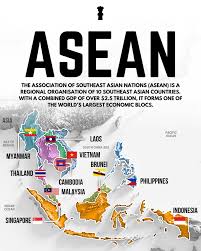
India’s Strategic Diplomacy in Southeast Asia: India seeks to strengthen ties with nations like Vietnam and the Philippines to counter China’s influence in the South China Sea while emphasizing peace and inclusivity in the Indo-Pacific.
Engagement with Myanmar: India continues to engage with Myanmar’s military regime for security reasons and regional stability despite international isolation following the 2021 coup.
Japan’s Asian NATO Dilemma: India opposes the formation of an Asian NATO to avoid escalating tensions with China and compromising its foreign policy flexibility.
The 19th East Asia Summit was held on October 11th, hosted by Laos. The East Asia Summit is an annual forum for leaders from East Asia, Southeast Asia, South Asia, and Oceania to discuss political, economic, and security challenges in the region. The summit gained prominence in 2005 with 16 participating countries. Key members include the 10 ASEAN nations, India, China, Australia, the Republic of Korea, Japan, New Zealand, the United States of America, and Russia.
Prime Minister Narendra Modi led India’s delegation at the 19th East Asia Summit, where he addressed several pressing issues facing the region. He emphasized the importance of peace and security, particularly in the Indo-Pacific, Eurasia, and the West, areas currently facing geopolitical challenges.

Prime Minister Modi highlighted the importance of peace, tranquility, openness, inclusiveness, and transparency in the Indo-Pacific region, as well as peace, security, and stability in the South China Sea. He stressed that countries’ freedoms should be defined by the United Nations Convention on the Law of the Sea (UNCLOS) and not through hegemonic actions by other nations. These points were subtle yet significant references to China, which has been exhibiting aggressive behavior in the South China Sea and surrounding regions.
This region is especially important as recent maritime disputes between the Philippines, Vietnam, and China have escalated. Both the Philippines and Vietnam are key strategic partners for India, and India has supported them in defense matters. For instance, India has supplied the BrahMos missile system to the Philippines and has a defense cooperation agreement with Vietnam.
Prime Minister Modi’s comments can be seen as a direct message to China, which has been undermining India’s interests in the region. By emphasizing these issues, India is asserting its concern over the region’s security and stability and reinforcing its commitment to a shared and cooperative Indo-Pacific. India’s stance is that opportunities in the region should not be monopolized by one nation but respected and equitably shared among all.

India’s policy in ASEAN has been strategic, especially recognizing that some ASEAN nations have strong economic dependencies on China. For example, in 2022, China provided a $6.1 billion loan to Laos for a railway project, deepening Laos’ dependence on Beijing. Cambodia has also become more aligned with China strategically. India, in contrast, seeks to create an alternative narrative, showing concern for these nations while maintaining its own partnerships, notably with the Philippines and Vietnam.
Both Vietnam and the Philippines are strong partners for India in the region, and due to this relationship, these countries have become more sympathetic to India, viewing it as a reliable ally. One of the major advantages of maintaining good relations with the Philippines and Vietnam is that it allows India to establish a more permanent presence in the South China Sea. This strategy could mirror China’s approach in South Asia, where Beijing has been strengthening ties with India’s neighbors and increasing its strategic access across the region.
If India can replicate this strategy with the Philippines and Vietnam, it would enhance India’s geopolitical leverage in the South China Sea, creating a strategic deterrent against China. Such a move would be a significant step in countering China’s influence in the region.
Prime Minister Modi emphasized the need to engage with Myanmar rather than isolate it, a notable stance given the military coup in 2021. India has maintained communication with Myanmar’s military regime despite the ongoing civil war, reflecting a strategic decision linked to national security. Myanmar’s instability directly impacts India, especially in regions like Manipur, where Kuki militants reportedly access weapons from Myanmar, and cross-border migration has worsened local unrest.
Geopolitically, Myanmar is vital for India’s regional goals, particularly through BIMSTEC, as SAARC remains largely inactive. Myanmar’s instability has disrupted BIMSTEC cooperation, affecting India’s aspirations in South Asia. The junta leader’s presence at the 19th East Asia Summit underscores the need for a solution to Myanmar’s crisis, with countries like India and ASEAN playing potential roles in restoring democracy once stability is achieved.
Japan & Asian NATO
India’s concerns extend beyond South and Southeast Asia, now involving East Asia and its ally, Japan. Recently elected Japanese Prime Minister Shigeru Ishiba proposed an “Asian NATO,” but Indian External Affairs Minister S. Jaishankar expressed reservations. India fears such an alliance would limit its foreign policy flexibility, increase dependence on certain countries, and escalate militarization in the Indo-Pacific, giving China a pretext for aggression. While rejecting the proposal, India is not siding with China but aims to maintain balanced relationships and avoid involving third parties in its disputes with China.
Japan’s Nikkei Asia criticized India’s foreign policy, claiming it has isolated itself in the region. The success of India-Japan relations under former PM Shinzo Abe and PM Modi was due to their independence from external influences, like the U.S. However, Japan’s foreign policy is increasingly aligned with American interests, which could create the perception that dealing with Japan means dealing with the U.S. To strengthen its regional standing, Japan should craft a more independent approach to Asian matters, distinct from the U.S., while maintaining alignment on global issues.
Aayush Pal is a freelance writer on contemporary geopolitical developments. The views expressed in his work are entirely his own.
